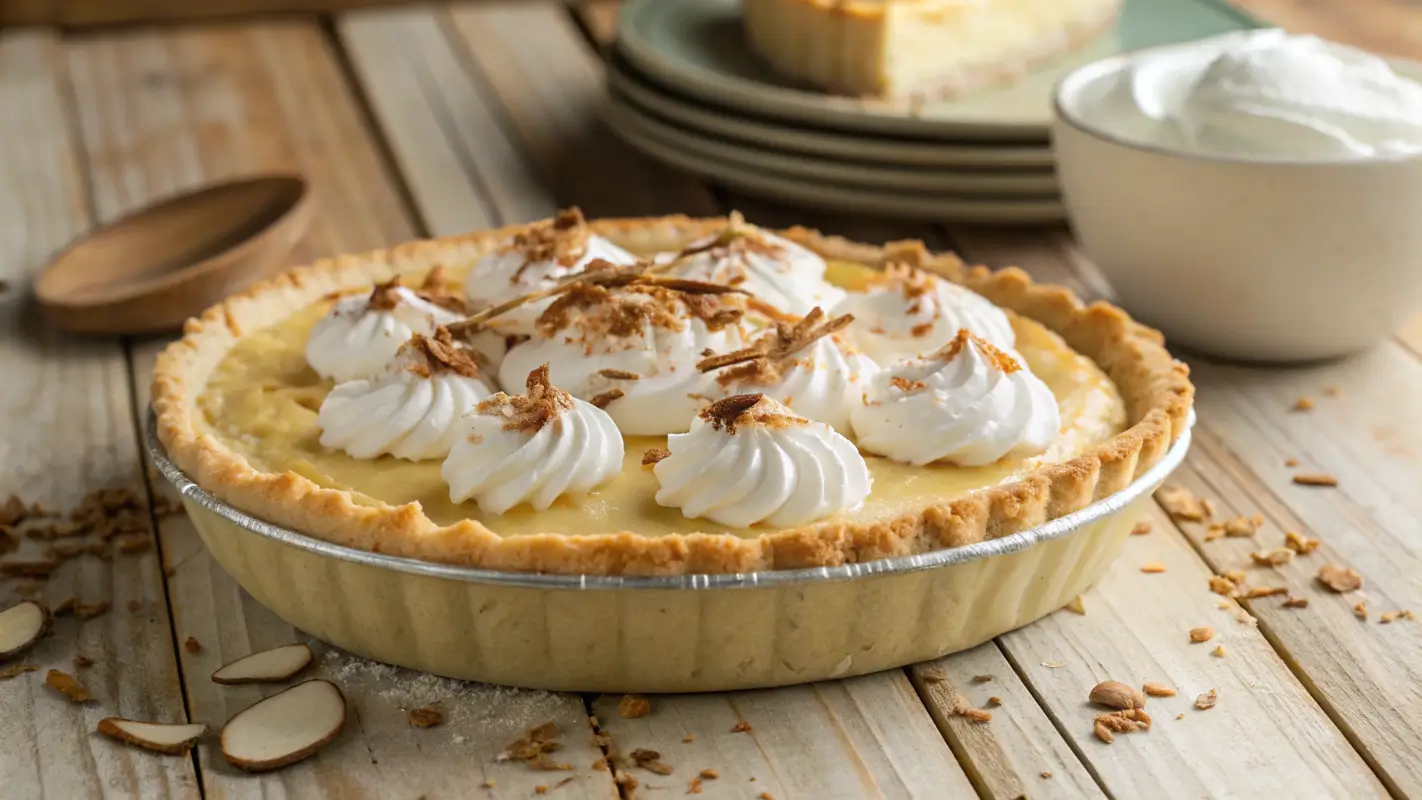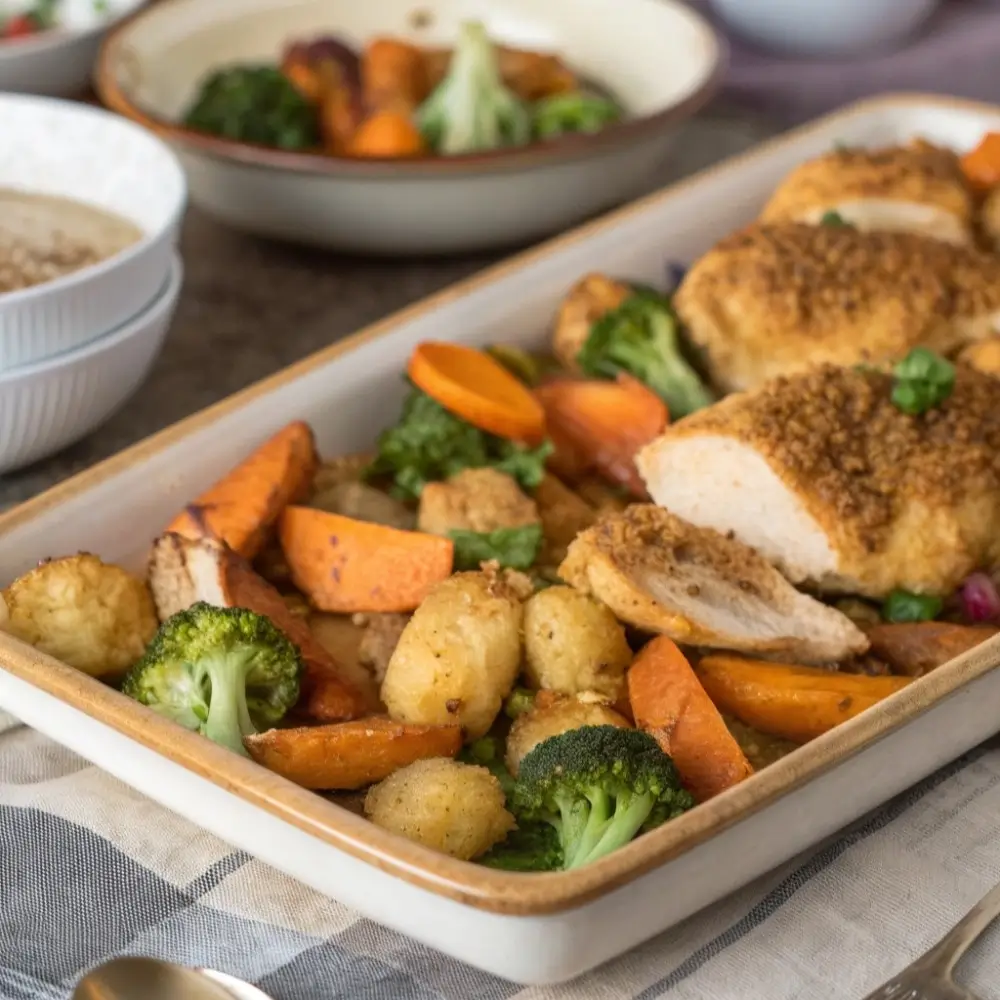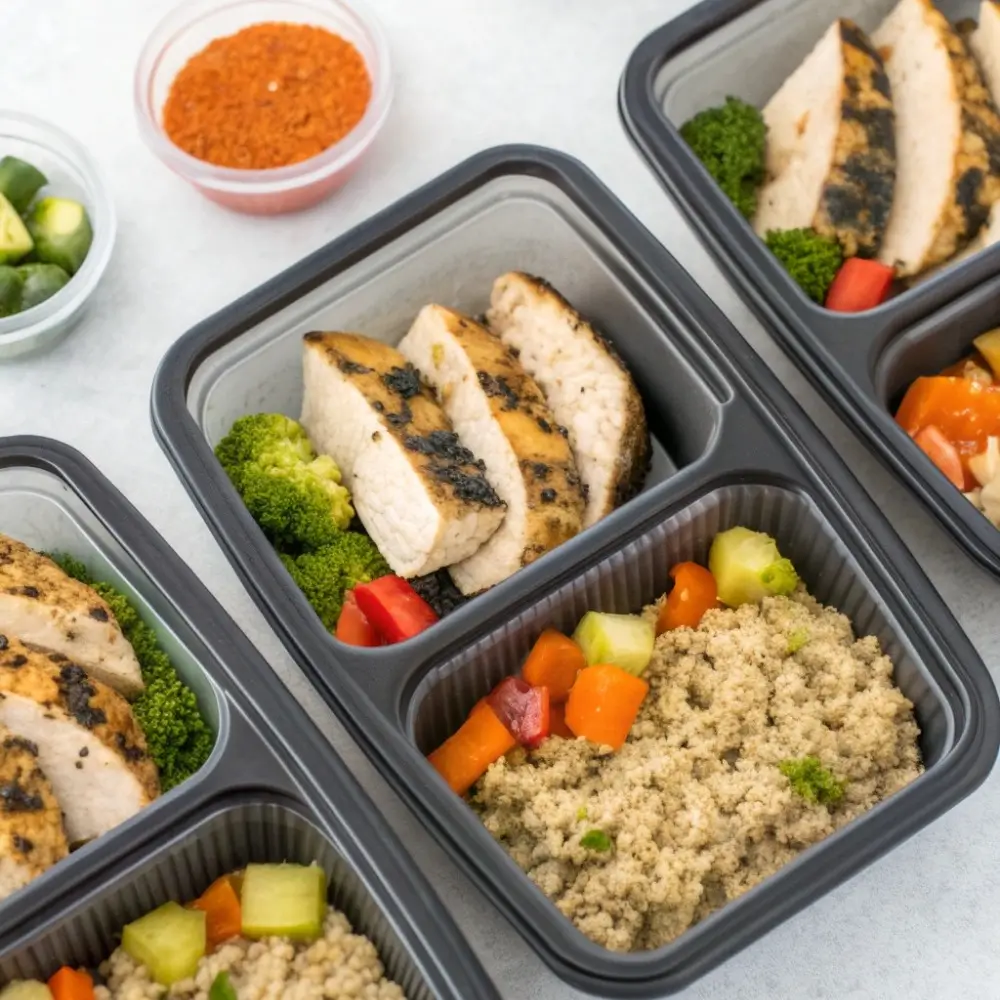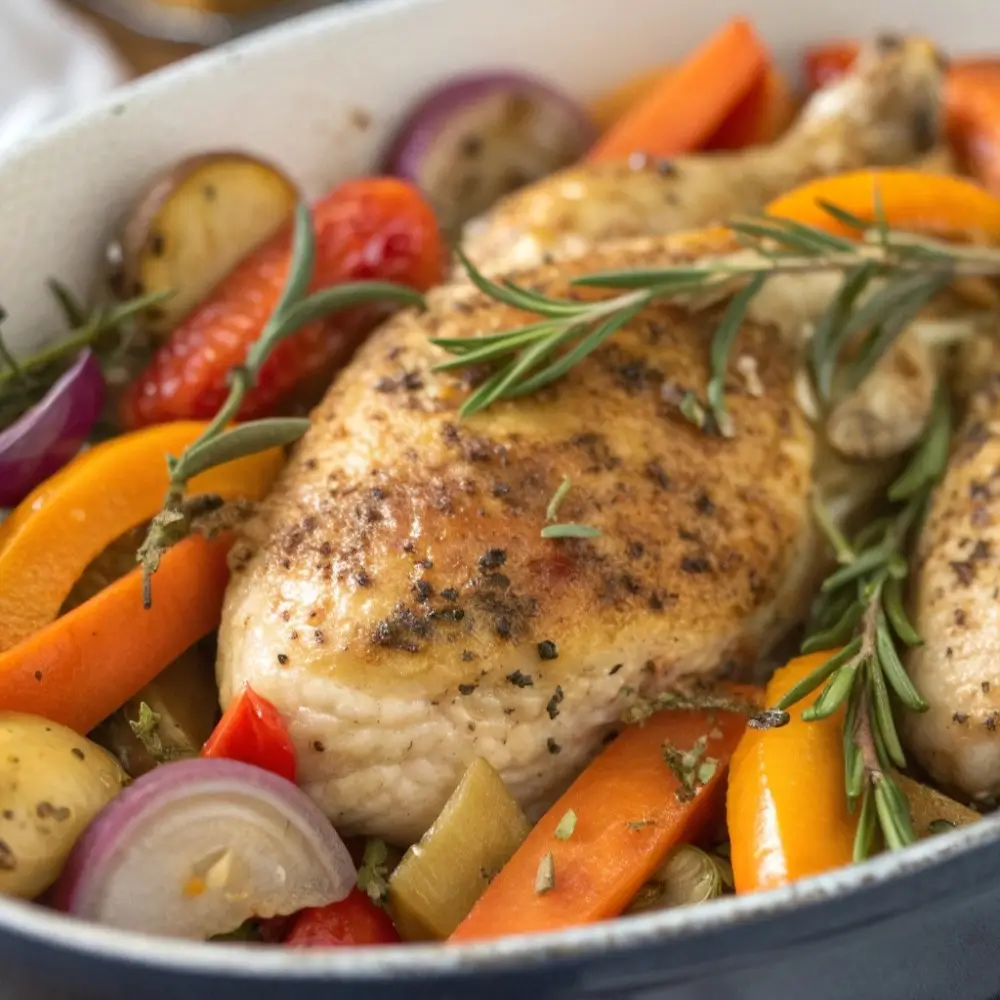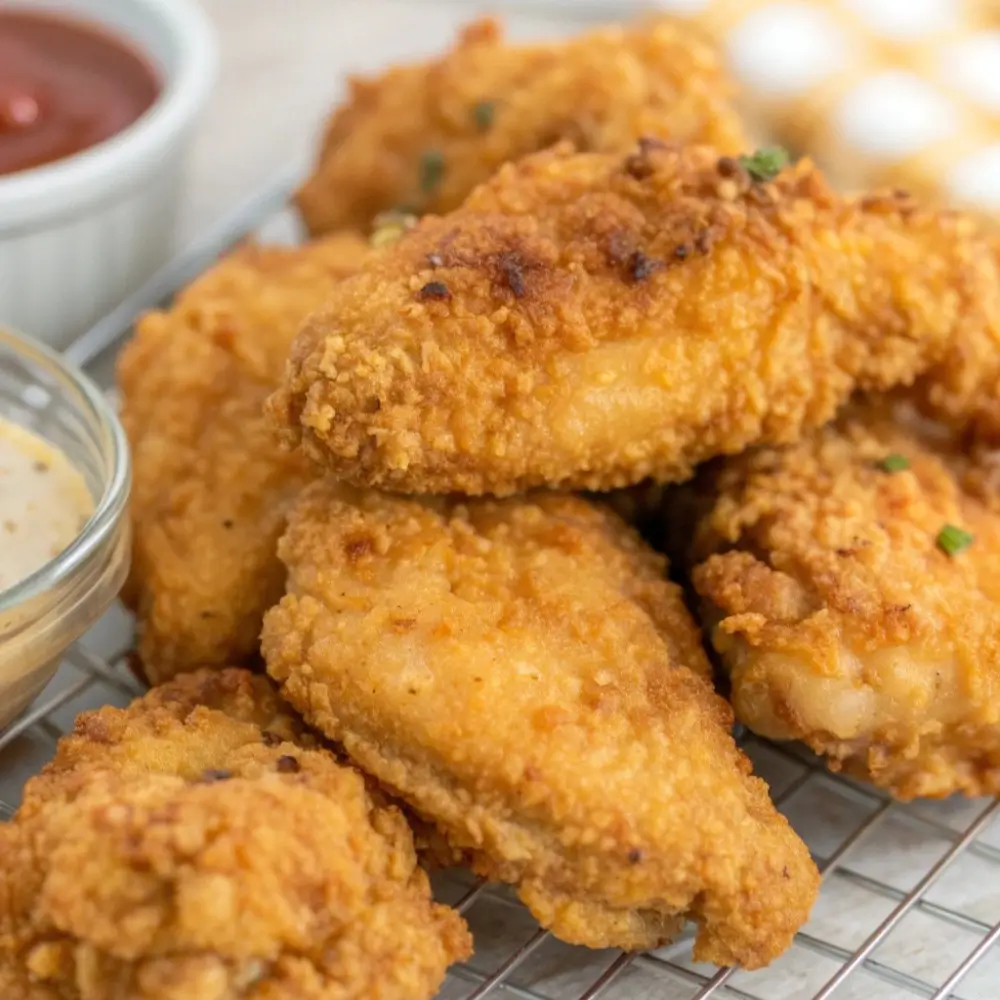Table of Contents
Coconut custard pie is a delightful dessert that brings the perfect balance of creamy custard and tropical coconut flavors. Whether you’re preparing for a holiday feast, a family gathering, or simply craving a comforting slice of pie, this recipe will surely satisfy your sweet tooth. The coconut adds a unique texture and flavor to the rich, smooth custard base, making it a crowd favorite. In this article, we’ll dive into everything you need to know about making the best Coconut Custard Pie Recipe— from understanding its key ingredients to offering creative variations, tips for perfecting the recipe, and more.
Understanding Coconut Custard Pie
What is Coconut Custard Pie?
Coconut custard pie is a deliciously rich dessert made with a smooth custard filling flavored with coconut and baked in a flaky pie crust. The custard is typically made from a mixture of eggs, milk, sugar, and coconut, giving it that perfect creamy texture. It’s an irresistible balance of textures: the custard is soft and velvety, while the toasted coconut provides a slight crunch.
This classic pie is popular in various cuisines around the world, with its origins often tied to the Southern United States or Caribbean islands. Depending on the region, some variations include different spices or flavorings, but the coconut is always the star of the show. Whether you’re making it for a special event or simply to treat yourself, coconut custard pie is an indulgent yet simple dessert that always hits the spot.
Key Ingredients for Coconut Custard Pie
Coconut
The star ingredient of this dessert, coconut gives the pie its signature flavor and texture. You can choose between sweetened or unsweetened coconut flakes, depending on your preferred level of sweetness. Shredded coconut is typically used, but flaked coconut can also be used for a bit more texture. If you’re looking to enhance the coconut flavor, consider adding a little coconut extract for extra depth.
Custard Base
The custard part of the pie is what makes it rich and creamy. Traditionally, this is made from a combination of eggs, whole milk, sugar, and vanilla extract. The eggs provide structure to the custard while the milk gives it a creamy texture. Some recipes may even call for heavy cream for a richer custard.
Pie Crust
The crust serves as the base of the pie, and while some may prefer to buy a pre-made pie crust, making your own can take the dessert to the next level. Whether you opt for a classic flaky pie crust or a graham cracker crust, the crust should be sturdy enough to hold the custard without sogging through. You can also opt for a gluten-free pie crust for those with dietary restrictions.
Equipment Needed for Coconut Custard Pie
To make coconut custard pie, you’ll need a few essential kitchen tools:
- A pie dish (9-inch standard size)
- Mixing bowls (for custard and dry ingredients)
- Whisk or hand mixer (for smooth custard)
- Spatula (for spreading custard evenly)
- Oven and baking sheets (to ensure even heat distribution)
Additionally, if you’re making the crust from scratch, a pastry cutter or a food processor will help speed up the process. These simple tools are all you need to create this delicious pie that will impress everyone!
Traditional Coconut Custard Pie Recipe
Ingredients:
- 1 pre-made pie crust (9-inch, or homemade if preferred)
- 1 1/2 cups sweetened shredded coconut
- 3 large eggs
- 1 1/2 cups whole milk
- 1/2 cup granulated sugar
- 1/4 cup unsalted butter, melted
- 1 teaspoon vanilla extract
- 1 tablespoon all-purpose flour
- Pinch of salt
Instructions:
-
Preheat the oven to 350°F (175°C). Place your pie crust on a baking sheet to make handling easier. If you’re using a homemade pie crust, make sure it’s fully chilled before proceeding to prevent it from shrinking during baking.
-
Prepare the custard filling: In a large mixing bowl, whisk the eggs and sugar together until well combined. Then, gradually add the milk, melted butter, vanilla extract, and pinch of salt. Continue whisking until smooth and creamy.
-
Add the coconut: Stir in the shredded coconut and flour to the custard mixture. The flour helps to thicken the filling as it bakes. Make sure the coconut is evenly distributed in the mixture to ensure a consistent texture throughout the pie.
-
Pour into the pie crust: Gently pour the coconut custard filling into the prepared pie crust. Be careful not to overfill. You want the custard to rise slightly as it bakes, so leave a little space at the top.
-
Bake: Place the pie in the preheated oven and bake for 45-50 minutes or until the center is set and a toothpick inserted into the center comes out clean. The pie will slightly puff up while baking but should settle once it cools.
-
Cool and serve: Once baked, remove the pie from the oven and allow it to cool to room temperature. This will help the custard firm up and give the flavors time to develop. You can also refrigerate the pie for an hour or two for a chilled version. Serve it plain or top it with a dollop of whipped cream or even a sprinkle of toasted coconut for added texture.
Tips for the Perfect Traditional Coconut Custard Pie
-
Crust tips: If you’re using a pre-made pie crust, make sure to prick the bottom of the crust with a fork a few times before baking to prevent it from puffing up. If you’re making a homemade crust, ensure it’s blind-baked (baked without the filling) for about 10-12 minutes to ensure a crisp texture.
-
Coconut variation: While sweetened coconut is commonly used, you can substitute with unsweetened coconut for a more subdued coconut flavor. Be sure to adjust the sugar in the recipe if using unsweetened coconut.
-
Custard consistency: If you prefer a firmer custard, increase the amount of flour by an additional tablespoon. This will make the pie hold its shape even more when sliced.
Creative Variations and Fusion Recipes
1. Chocolate Coconut Custard Pie
For a twist on the traditional coconut custard pie, try incorporating chocolate into the filling! Add 1/2 cup of melted dark chocolate or cocoa powder to the custard mixture before pouring it into the pie crust. The combination of chocolate and coconut is a match made in dessert heaven. You can also top it with a layer of chocolate ganache or sprinkle chocolate chips over the filling for added decadence.
2. Caramel Coconut Custard Pie
Add a caramel layer to the pie for an extra burst of sweetness. Start by preparing a caramel sauce by melting sugar in a pan over low heat until golden brown. Pour this caramel over the custard filling just before baking. The rich caramel flavor complements the coconut beautifully and creates a gooey surprise in every bite. You can also drizzle additional caramel sauce on top after baking for that extra indulgence.
3. Key Lime Coconut Custard Pie
This fusion recipe brings the refreshing zing of key lime to the coconut custard pie. Add the juice and zest of 2 key limes to the custard mixture for a burst of citrus flavor that balances the richness of the coconut. This variation is perfect for a summer dessert that combines tropical flavors in a fresh and tangy way.
4. Coconut Custard Pie with Almonds
If you’re a fan of nuts, try adding some sliced almonds to your coconut custard pie. You can stir the almonds directly into the custard mixture or sprinkle them on top before baking. The almonds will toast as the pie bakes, giving it an extra crunch that pairs perfectly with the smooth custard. You could also opt for toasted coconut flakes as an added topping for texture.
5. Vegan Coconut Custard Pie
For those following a plant-based diet, it’s easy to create a vegan coconut custard pie. Swap the eggs with flax eggs (a mixture of ground flaxseed and water) and use coconut milk or almond milk in place of whole milk. You can also substitute vegan butter for the traditional butter. The result is a creamy and satisfying pie that everyone can enjoy.
Tips for Creative Variations:
-
When experimenting with chocolate, make sure to choose a high-quality dark chocolate to balance out the sweetness of the coconut.
-
For caramel, be cautious when making the sauce as sugar can burn quickly. If you’re new to making caramel, consider buying pre-made caramel sauce.
-
Adding key lime or citrus flavors works best in the summer when you want a refreshing contrast to the rich custard.
-
When using nuts, be sure to toast them lightly to enhance their flavor and prevent them from getting too soft during baking.
Tips for Perfecting Your Coconut Custard Pie
Making a delicious coconut custard pie might seem straightforward, but there are a few key tips and tricks that can help you take it to the next level. Follow these helpful suggestions to ensure that your pie comes out perfect every time!
1. Perfect the Pie Crust
Whether you’re using a store-bought or homemade pie crust, the foundation of your coconut custard pie matters. A flaky crust enhances the overall experience, so make sure your pie crust is properly prepared. If using a pre-made pie crust, blind bake it for 10 minutes to prevent it from becoming soggy. For homemade crusts, ensure it’s chilled well before filling to avoid shrinking during baking.
2. Don’t Overmix the Filling
When preparing the coconut custard filling, it’s important not to overmix the ingredients. Overmixing can cause the eggs to become frothy, which could result in an uneven texture in the finished pie. Gently whisk everything together just until the ingredients are incorporated—this will give you a smooth and creamy custard.
3. Use Full-Fat Milk for Creaminess
For the creamiest custard texture, stick to using whole milk or full-fat coconut milk. While you can substitute lower-fat milk, the custard may lack the richness that makes this pie so special. Heavy cream can also be used for an even creamier filling, though it’s optional.
4. Monitor the Baking Time
Overbaking can cause your coconut custard pie to become dry, while underbaking can result in a runny filling. The key is to bake until the custard is set and the center is just slightly jiggly. You can check this by inserting a toothpick into the center—if it comes out clean, the pie is ready.
5. Let It Cool Properly
After baking, allow your pie to cool completely before slicing. The custard filling will continue to firm up as it cools, ensuring that your slices hold their shape. If you’re in a rush, you can refrigerate the pie for a few hours to speed up the cooling process, but giving it time to rest at room temperature ensures the best texture.
6. Add Toppings for Extra Flair
While coconut custard pie is delicious on its own, adding toppings can give it that extra wow factor. Whipped cream or toasted coconut is a classic choice. You can also drizzle some chocolate sauce, caramel, or even fresh fruit for a unique twist.
For more tropical dessert ideas, explore this guide on how to make tropical-inspired desserts.
Frequently Asked Questions On Coconut Custard Pie Recipe
1. Can I Make Coconut Custard Pie Ahead of Time?
Yes! Coconut custard pie can be made ahead of time and stored in the fridge. In fact, it often tastes better the next day as the flavors meld together. Make sure to cover it properly to keep it fresh and prevent it from absorbing any unwanted odors from the fridge.
2. Can I Use Coconut Cream Instead of Coconut Milk?
Yes, you can use coconut cream instead of coconut milk for a thicker, creamier texture. Coconut cream will result in an even richer custard, so keep that in mind when making your recipe.
3. Can I Make a Gluten-Free Coconut Custard Pie?
Certainly! Simply use a gluten-free pie crust to make your coconut custard pie completely gluten-free. You can find pre-made gluten-free pie crusts at most grocery stores, or you can make your own from scratch using gluten-free flour.
4. What Can I Use Instead of Eggs in Coconut Custard Pie?
If you need to make the pie egg-free, you can substitute the eggs with a flax egg (1 tablespoon ground flaxseed + 3 tablespoons water). This will give you a similar texture, though it may slightly alter the flavor.
5. Can I Freeze Coconut Custard Pie?
Yes! Coconut custard pie can be frozen for up to 2-3 months. After baking, let the pie cool completely, then wrap it tightly in plastic wrap and foil before freezing. To thaw, simply place it in the fridge for several hours or overnight before serving.
Conclusion
Making a coconut custard pie is a rewarding experience, and with the right tips, tricks, and creativity, you can elevate this classic dessert to a whole new level. Whether you’re sticking to the traditional recipe or trying out creative variations, the creamy, tropical flavors of coconut will undoubtedly shine. Enjoy this perfect dessert any time of year, and share it with friends and family for a treat that’s always a hit!
